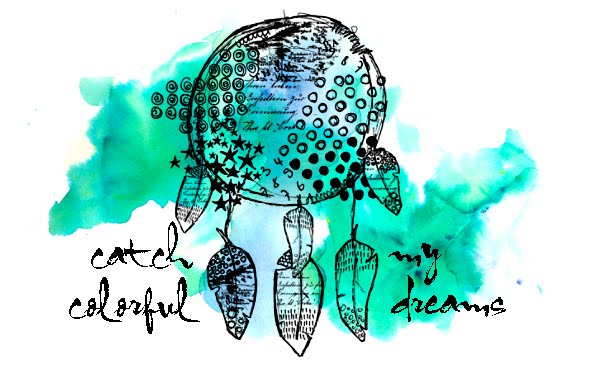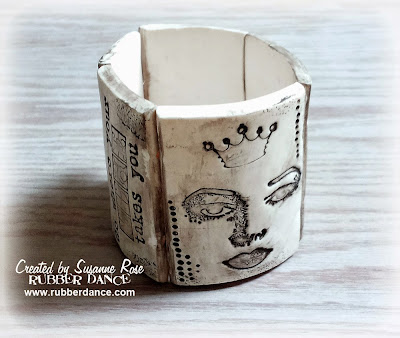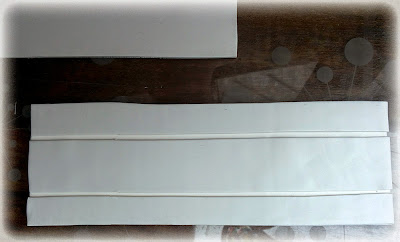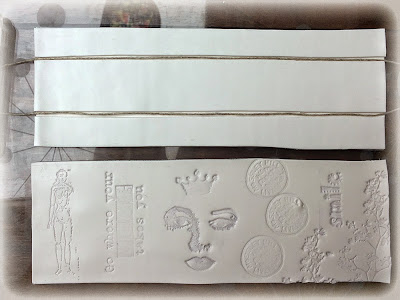Heute möchte ich endlich mal wieder ein Schmuckprojekt aus Fimo zeigen. Im Post findet Ihr eine Schritt für Schritt Anleitung.
Today I'd like to share a jewelry
project with you. I created a chunky bracelet by stamping on polymer
clay. You'll find detail photos and step by step instructions in this
post.
Material:
ca. 50g weiß und 50g pearl Fimo (oder ähnliches)
Stempel
Nudelmaschine und Cutter
Acrylfarbe (schwarz und braun)
Elastische Schnur
Twine
Falzbein
Etwas rundes zum backen des Armbands (Glas oder Desserring, mit Alufolie drumrum)
Eine Perle für den Verschluss
Scharfes Küchenmesser
Ofen zum backen
Nassschleifpapier (ca. 300)
Supplies:
ca. 50g White and 50g Pearl Fimo (or similar clay, any brand)
Stamps and other stylus tools
Pasta machine would be good, also a cutter blade
Acrylic paint (anything dark, I mixed black and brown)
Elastic cord
Some twine
Bone folder
Something round like a marmalad glass, a glass bottle or something like that with a diameter of nearly 8-10cm (cover it with aluminium foil)
Any bead for the closure
Sharp kitchen knife
Of course an oven to bake the clay
Waterproof sandpaper (about 300 grit)
Step 1:
Ihr benötig verschiedene Platten der Fimomischung (weiß und pearl). Eine für die Rückseite, eine für das Mittelstück und eine für die Vorderseite. Die Größe passt Ihr am besten individuell an Eurem Arm und am größten Stempelmotiv an. Meines ist 19cm x 6cm. Das Fimo konditioniere ich mit der Nudelmaschine.
You
will need different sheets of your clay mixture (white and pearl). One
for the backside, one for the middle part and one for your stampings.
You should choose the size you need and want. I used a length of 19cm
and a height of 6cm (fitting my highest image). I conditioned the clay
with my pasta machine using a middle setting.
Step 2:
Jetzt ist es an der Zeit Eure Motive zu stempeln. Besprüht dazu jeden Stempel vorher mit etwas Wasser, damit das Fimo nicht am Stempel kleben bleibt. Am besten testet Ihr das erst mal auf einem Reststück um ein Gefühl dafür zu bekommen. Die Stempel müssen im Anschluss immer gut gereinigt werden!
Stamp
your images by spraying your stamps with some water (so that the clay
will not stick to it) and press it into your clay. It might be a good
idea to test this process first on a piece of scrap clay. Just to get
some feeling for it. Be sure to clean your stamps very well after you worked with polymer clay!!!
Neben den Stempel hab ich noch einige andere Strukturen kreiert.
I used other stylus tools as well in addition to the stamps.
Step 3:
Nun kommt der Mittelteil auf die Rückseite. Drückt ihn dazu leicht an.
Press the middle part onto the backside.
Um die Fädellöcher zu schützen lege ich etwas Garn hinein und gebe das Cover darauf.
Add some twine into the openings to protect them and press the "cover" on top:
Step 4:
Leider hab ich hier vergessen ein Foto zu machen. Bevor das Armband gebacken wird werden die Einzelnen Teile, die Ihr später haben wollt, mit dem Falzbein markiert. Hierzu drückt Ihr vorsichtig das Falzbein ins Fimo. Nun legt Ihr das Armband um Euer rundes Objekt. Ich verwende einen Dessertring. Bindet das Garn zum Fixieren zusammen. Und jetzt ab in den Ofen.
Sorry, I missed it to take photos of this step. Take your bone folder and
press it into your bracelet where the single parts should be cutted
after baking. Press it not too deep. Take your "construction" and lay it
arround your glass (or other round and heat-proof object). Tie the ends
of your thread together to fix it. Now you can put it into the oven by
following the clay manufacturer's instructions.
Step 5:
Nach dem Backen können die einzelnen Perlen mit dem Küchenmesser auseinandergeschnitten werden. Die scharfen Kanten werden mit Nassschleifpapier unter wasser abgeschliffen.
After baking you can cut the pieces apart with a sharp kitchen knife. Take your waterproof sandpaper and sand the sharp edges under water.
Nun malt Ihr jede Perle mit Acrylfarbe and und wischt einen Großteil der Farbe im Anschluss mit einem feuchten Tuch wieder ab.
Paint every part with acrylic paint and wipe the color away with a damp cloth rag.
Step 6:
Jetzt können die fertigen Perlen aufgefädelt werden. Für den Verschluss knotet Ihr die extra Perle an das eine Ende und könnt diese nun durch die Schlaufe am anderen Ende führen.
Thread your finished beads onto the elastic cord. Build the closure by tying an extra bead on the end. This bead can be run through the cord loop on the other end.
All stamps I've used are from Rubber Dance:
Collage Mix,
Vintage Birds,
Think again




















Wow, fantastic make, thanks for the tutorial. Creative Blessings, Tracy x
ReplyDeleteEcht cool!
ReplyDeleteDas rockt! Vielleicht friemel ich doch mal mit Fimo (:o)
ReplyDelete